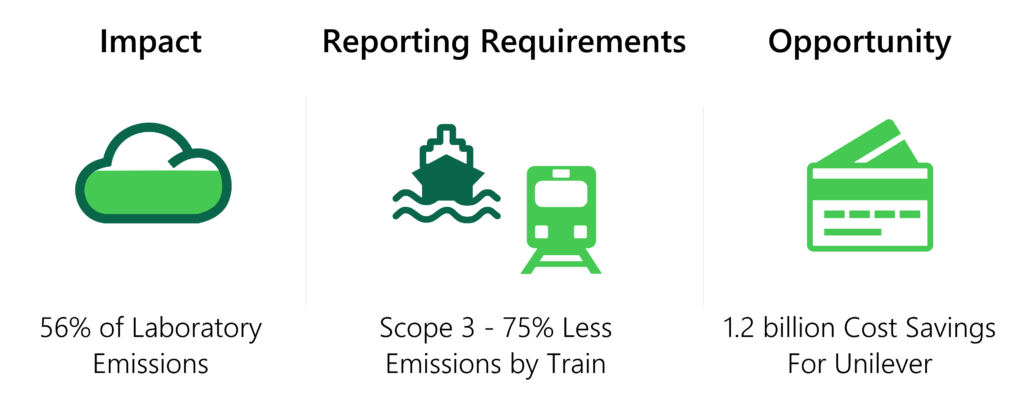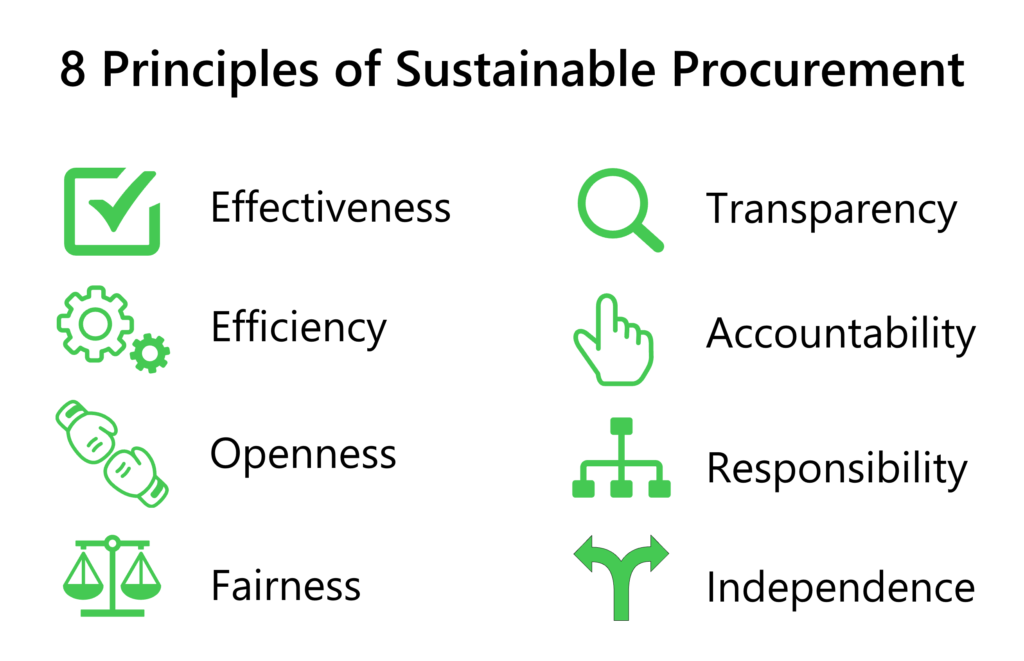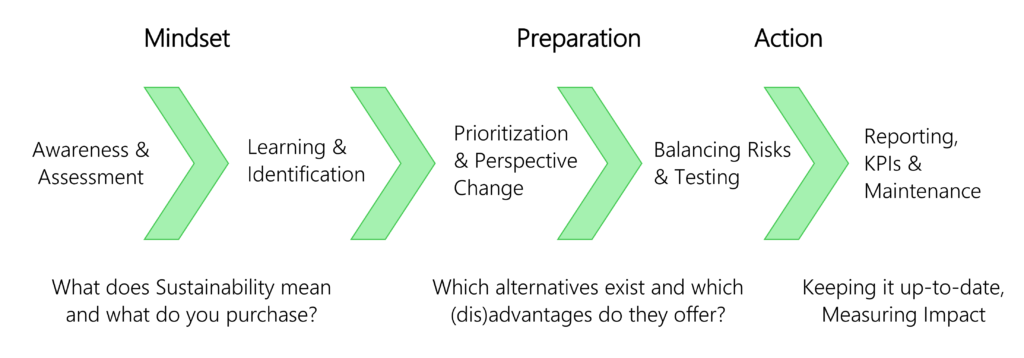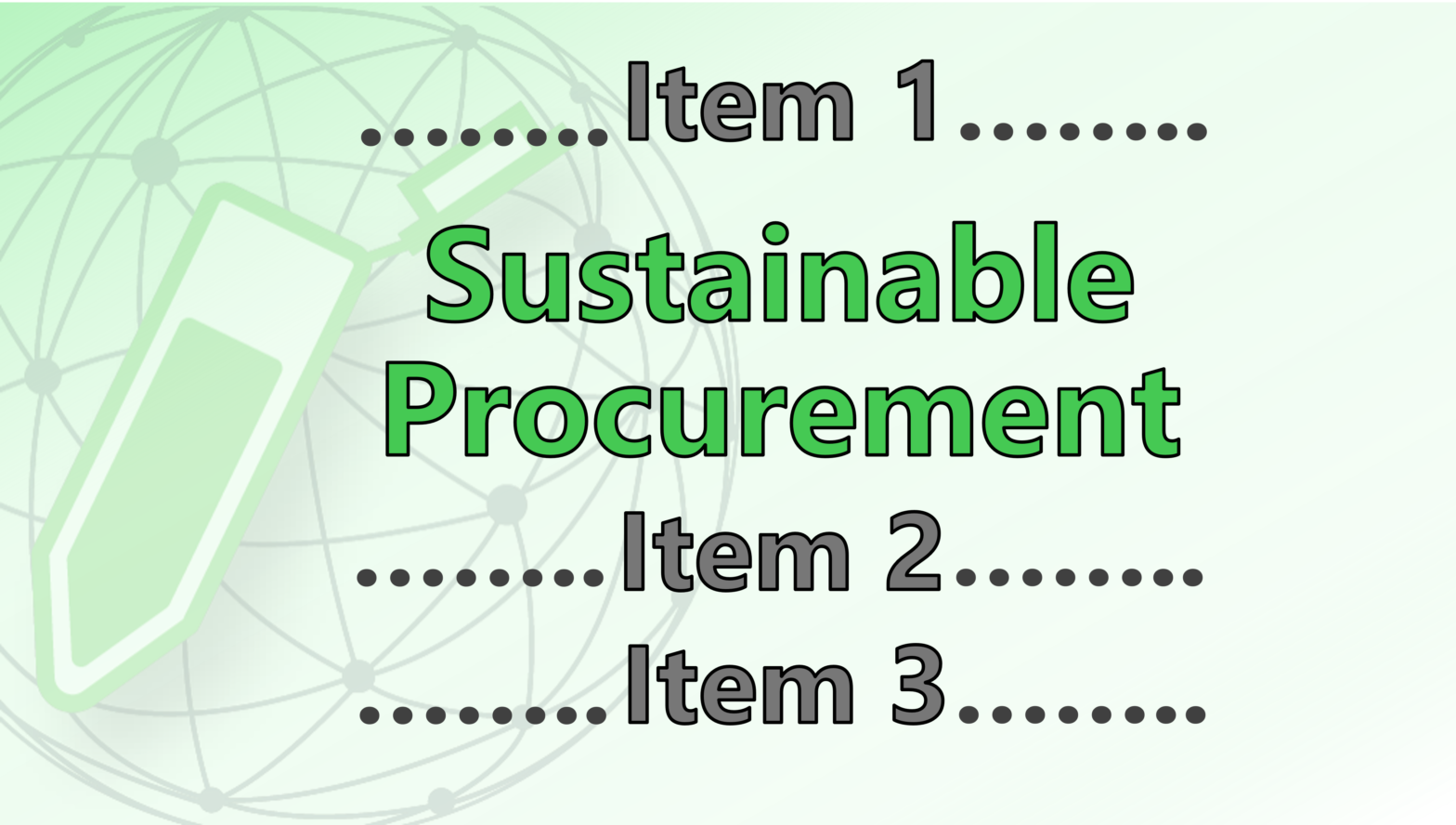By Patrick Penndorf
Procurement. In other words, the process of purchasing items and services for your laboratory.
When I first delved into the world of procurement, I was met with a lot of complex jargon and convoluted advice. It felt confused and uncertain about my next step.
Therefore, let me share what I have learned to help you make sense of this topic:
If you do not want to read the entire article, here is my key take-away: As everything related to sustainability in science, sustainable procurement is about prioritizing differently. Instead of choosing the easiest solution, it is about balancing environmental, societal and economical impacts. It always comes at a cost (time, effort, risk) upfront but will pay off in the long turn.
Why Procurement Matters
Did you know that a significant chunk of laboratory emissions stems from purchasing? One Preprint found that up to 56% of laboratory missions can be attributed to procurement alone.

Also, more regulations that require companies to report about their footprints are released. Especially the EU is moving quickly (e.g., CSRD). Even for academic laboratories such obligations could be a reality soon. Their universities, funding bodies or the government might ask for such data.
Still, it not just about saving the planet; there are tangible cost savings too. Companies like Unilever, Pepsico, and Nike have saved millions by optimizing their procurement processes ($1.2 Billion, $60 and $50 million respectively).
But What Is SUSTAINABLE Procurement?
Sustainable procurement is revisiting and shifting our purchasing priorities to make it about more than just buying what fits. It is about valuing environmental, social, and economic factors as well.
There are 8 “factors” that in my opinion explain well what it means to prioritize sustainability (and to make this section not too dry, I will add a bit of black humor to illustrate what it should NOT look like):
Effectiveness – buying what (actually) align with your organization’s goals.
“You said DNA-Prep Kits, I understood NEW COFFEE MACHINE“
Efficiency – reducing expenses, emissions and environmental damage to a minimum.
“Although it took 8 months for my product to arrive, it at least has seen every continent on earth – I am so proud!”
Competitive Openness – inviting (all) suppliers to compete for the best offer (in terms of price as well as environmental impacts).
“No need for tedious online research, my friend is assembling CRISPR Kits in his garage”
Transparency – you should know and share where your products come from, how they’re made, and what their environmental footprint looks like.
“Phh that number is so long it could be my phone number, just put into in the supplementary of the additional information in the attachments”

Fairness – avoiding discrimination of certain providers and contributing to proper cooperation.
“I hate their logo, this blue tone is off-putting, they are out!”
Accountability – holding both yourself and your suppliers accountable for ethical practices, whether it’s fair labor conditions or responsible sourcing of materials.
“I think Tony messed up again … but anyway, he is paying for the beer so don’t mess with him!”
Responsibility – recognizing the broader impact of your procurement choices.
“Environmental exploration – I would be glad if that would finally happen here so they could start building this new highway…”
Independence – making purchasing decisions based on objective criteria rather than external influences or biases (e.g., from single stakeholders).
“But the oracle (aka my neighbor who works at this company) has forsaken that this is going to be the new gold-standard in a few years”
Independence – making purchasing decisions based on objective criteria rather than external influences or biases (e.g., from single stakeholders).
“But the oracle (aka my neighbor who works at this company) has forsaken that this is going to be the new gold-standard in a few years”
But In How Far Does That Relate To The Laboratory?
Most changes in your procurement have to happen in alignment with your laboratory. And some can only be sparked there. To provide some examples, here are four of them:

Collaboration and Resource Sharing
Reduction is king. Before making a purchase, explore opportunities for collaboration or resource sharing. Can you partner with other labs to share equipment or borrow chemicals? Setting up an excel or designated chat/Email Group to inquire can be helpful for larger institutes.
Reduce delivery footprints through collective purchasing and bulk orders, especially in institutions with multiple labs. By pooling resources and purchasing in bulk, you can not only save costs but also reduce packaging waste. And for laboratories with smaller financial resources, it might be the only way to afford some especially expensive antibodies or equipment.
Reviewing Procurement Practices
Do you need to reorder, or can you reuse? Some columns can be recovered, while tubes for commonly needed solutions can be reused. Instead of purchasing entire DNA isolation kits, reuse collection tubes to safe money and only buy the columns (QIAGEN offers that for example).
Especially for academic laboratories, mindful organization and distribution of laboratory are often lacking. Keep track of expiration dates and where stocks are kept. This will save a lot of time and money. Also, multiple people accepting deliveries an putting items in various storage locations can result in items getting lost. Software and systems for inventory management are available (even for free) – and sometimes an excel sheet will do too.
Exploring Innovation And Alternatives for Solvents & Reagents
Explore which new items and equipment exist to save energy, chemicals and resources. Some MS and HPLC machines already use less chemicals/eluents and need less energy. Eppendorf produces tubes made to 90% out of plant oil waste streams.
Especially for laboratories in the bioeconomy, can you repurpose waste streams or adopt alternative methods that require fewer resources?
Make use of resources such as the solvent guide from the University of Pennsylvania to identify sustainable alternatives for commonly used solvents. Get informed about the 12 principles of green chemistry. Software such as the DOZN Tool make it easier to optimize experimental procedures (solvent choice, reaction conditions, and waste minimization strategies etc).
Finding Better Options To Order Your Products
Look for suppliers offering eco-friendly alternatives for the items you need. As mentioned, consider bio-based products like Eppendorf tubes made from recycled plant oil waste streams.
Shift your focus towards suppliers that prioritize sustainable delivery methods and packaging materials. Vendors like NEB, utilize paper and hemp-based products instead of traditional plastic for packaging. Additionally, inquire about innovative shipping practices, such as sending items at ambient temperatures to minimize the need for cooling materials (especially ice packs) and insulation (available e.g., for primers).
Also, what happens to your items “downstream” is a factor to be considered. Opt for items with eco-friendly disposal options, such as paper cartridges from Labcon instead of traditional plastic counterparts. Additionally, suppliers like Rainin offer easily recyclable pipette tip boxes. Others offer to take back your waste (but take care, some of them just discard it themselves and thereby cause a higher footprint due to additional transport).
Let’s Be Honest
While the principles might seem straightforward at first glance, putting them into action can be a complicated task.
Sustainable procurement isn’t just about being eco-friendly; it’s about finding the delicate balance between environmental, economic, and social considerations.
Can you trust all claims made? Theoretically, certification should help you make the decision. We give some tips and introduce the top 5 most important certifications in another article of ours.
And we cannot forget, all change inherently involves risk. What if the new product or supplier that seems to be of superior quality doesn’t deliver in time?
To make it easier for you, here is an actionable plan. It also summarizes the information from above:
A Five-Step Roadmap To Get Started
1. Awareness & Assessment
Begin by actively trying to understand what sustainable procurement entails. Understand the environmental, economical and social impacts associated with the items and services you procure. Assess your current procurement practices (i.e., everything that you did not consider to be important so far). So far, it is not about finding solutions, just to get used to take the knowledge from this article and translate it to your laboratory. Also, you will discover more as you go along, no need to get paralyzed at this step.
2. Learning & Identification
This is the most painful step – it takes time to learn about sustainability and alternatives available in the market. Explore different products, suppliers, and procurement practices step by step. Often, it is 50% active search and 50% keeping an open mind to notice interesting alternatives (here, the algorithms suggestion you solutions can become your friend) Educate not only yourself but leverage your team as well – again, remind them that there is a lot of money to be saved.

3. Prioritization
There is no perfectly sustainable procurement. You need to find what is most important to you and where you are ready to take a step back. Consider whether certain purchases are essential. Evaluate the importance of factors such as environmental impact, supply chain ethics, and end-of-life considerations for you personally (or your laboratory or company). This will also depend on your circumstances, i.e., which possibilities and freedom you have.
4. Balancing Risks & Testing
Each and every change comes at a risk. Recognize that transitioning to sustainable procurement will involve uncertainties too. No perfect solutions available. Conduct thorough risk assessments before implementing changes. If possible test alternative products or practices on a small scale to gauge their effectiveness and reliability. And do not be disappointed if some alternatives seem just to risky. Times will change and at the start of new projects, changes are implemented more easily.
5. Reporting, KPIs & Maintenance
Establish key performance indicators (KPIs) to measure the impact of sustainable procurement efforts. Develop a reporting framework to track progress and communicate achievements internally and externally. Stay informed about emerging regulations and industry standards related to sustainability reporting. Regularly review and update procurement practices to maintain alignment with sustainability goals.
If this article contained any useful information for you, you can always join our weekly lessons, live events for free: https://forms.gle/iGkDKX4XDRTUnsRVA
Or you can follow us on social media where we share these lessons in bit-sized chunks: https://linktr.ee/readvance
Finally, if you want to see some real-life examples of how to go through websites from providers, you can watch our recording (and there you can also see me in person ; )

